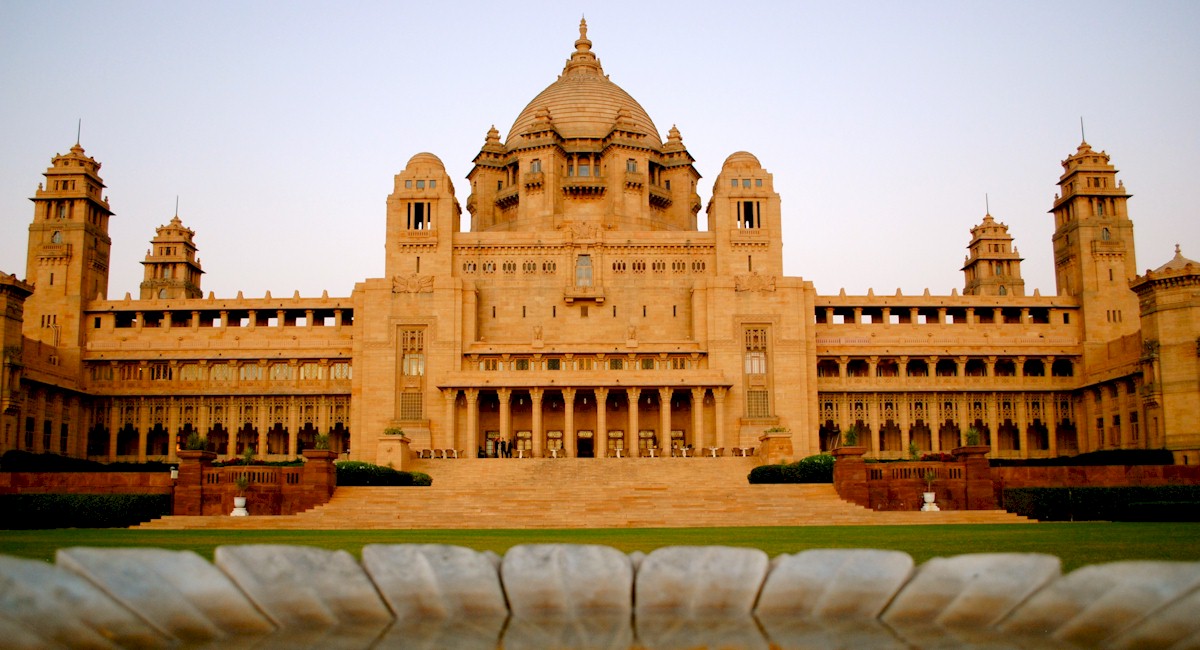
Umaid Bhawan Palace
Also known as Chittar Palace, this monument is
divided into three areas, namely a heritage hotel,
museum and the Maharaja’s royal residence. Umaid Bhawan
Palace is one of the most exclusive hotels of Jodhpur.
An architectural marvel, it is equipped with all modern
facilities and offers a royal experience.
Marbled squash courts, billiards rooms, a private museum
and much more await you here. Visit the museum to see
royal artifacts and armour, old clocks, glassware and
other miniatures that are on display.
Mehrangarh Fort
A magnificent historical edifice that serves as the crowning glory of Jodhpur, this fort stands on top of a raised hillock that is 400 metres above the level of its surrounding terrains. With its sprawling expanse, it prides in being one of the largest forts present across the country. The eventful history, well-preserved heritage and impressive architecture of this fort make it the face of Jodhpur on national as well as global platform.
Mehrangarh – a word for 'fort of the sun' – was
chosen as the name of this massive structure that is 500
yards long and features 120-feet high and 70-feet thick
walls. Today, this fort is preserved and owned by
Maharaja Gaj Singh II – the current Rathore ruler.
The highlights are its seven imposing entrances, which
include the famous Jai Pol (victory gate) and Fateh Pol.
Exquisitely designed palaces like Moti Mahal (Jodhpur
Zenana), Sheesh Mahal, Takhat Vilas and Phul Mahal speak
of the architectural splendour of the royals. Mirror
work, intricate ornamentation, beautiful glass panel,
alcove and impressive woodwork adorn these palatial
buildings.
A large part of the Mehrangarh Fort has been converted
into a heritage museum, which is one of the finest
museums across the country. The three-storey Daulat
Khana Gallery houses treasured artefacts related to
Rathores. Visitors can purchase exclusive souvenirs from
the museum shop, which is the only such shop in the
country.
Jaswant Thada
The Jaswant Thada is an architectural marvel with
intricate carvings. Famed as one of the most beautiful
white marble cenotaphs, it was built in 1899 by Maharaja
Sardar Singh in commemoration of his father Maharaja
Jaswant Singh II. This white marble wonder of Rajasthan
is often called the Taj Mahal of Marwar. The splendid
edifice is a perfect example of Rajputana style of
architecture. Its impeccable design and architecture is
symbolic of the fine craftsmanship of the bygone era.
The main memorial is built like a temple, with beautiful
domes and finely carved sculptures. Visitors can see
here beautiful portraits of the various rulers of
Jodhpur. The complex also features a memorial of a
peacock that flew into a funeral pyre. Magnificently
carved gazebos, an exquisite multi-tiered garden and a
small lake surround the cremation ground.
Umed Garden Zoo
Meet exotic birds from Africa and Australia. Watch
ducks and rabbits play among themselves as you visit the
‘Walk-in Aviary’ at the Umed Garden Zoo. This place is a
must visit if you are travelling with kids. It promises
a fun-filled and memorable experience in addition to
loads of exciting photo opportunities.
Let children watch animals in their natural habitat as
you visit the Umaid Garden Zoo in Jodhpur.
Government Museum
Visit the Government Museum to see a unique display of the rich collection of weapons, textiles, miniature portraits, local crafts and images of Jain Tirthankaras (sages). Other than that, you would find many interesting artifacts here. A visit to this popular museum is a must if you are a lover of history and archaeology.
Mandore Garden
Mandore Garden is a heritage spot, situated in its
namesake town, towards the outskirts of Jodhpur. After
the town was abandoned for the protection of the
Mehrangarh Fort, the garden remained as a reminder of
its glorious past. This garden has a high rock terrace,
which is its most prominent attraction.
Cenotaphs (dewals) of Jodhpur's erstwhile rulers are
dotted across this landscaped garden, which are
different from those found in other regions of
Rajasthan. These red sandstone cenotaphs resemble Hindu
temples and have four storeys, elaborately designed
columns and tall spires. Notable amongst these dewals
include the memorial dedicated to Maharaja Ajit Singh
and other built for the Maharani atop a hill.
The hall of heroes, dedicated to brave Rajput fighters
and Hindu deities, lies close to these cenotaphs.
Colourful rock statues and images of these heroes and
Gods adorn this hall.
'The Shrine of the Three Hundred Million Gods' is an
unmissable thing of interest in Mandore Garden. Vibrant
illustrations of Hindu Gods are present here, which
depict the brilliance of artists of those times. On
climbing the nearby hill, visitors get to see the old
palace and ruins of Mandore.
Phalodi Fort
Phalodi Fort is a historical site, located in the
small city of Phalodi in Jodhpur. This imposing edifice
was built in 1488 by Rao Hammir Narawat, the grandson of
Rao Suja Maharaja of Jodhpur.
The fort reflects the fine work of artists of Marwar of
the bygone era.
Rao Jodha Ji Statue
Rao Jodha Ji Statue is set on a small hilltop along
the road that leads to Jaswant Thada (near the
Mehrangarh Fort). It was built in the honour of Rao
Jodha Ji, who founded the beautiful city of Jodhpur.
The statue, encircled by iron grills, depicts Rao Jodha
Ji on a horse, pointing towards the fort. This
magnificent statue was installed on 12th May 2012, the
554th Jodhpur Foundation Day.

Send Enquiry